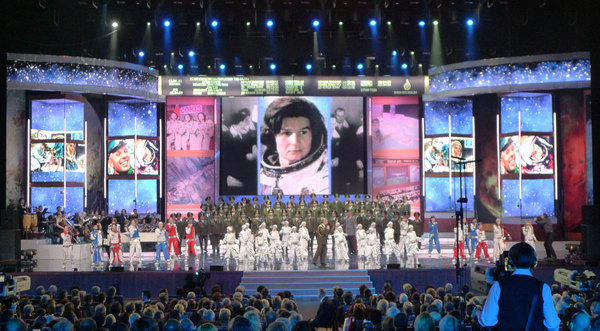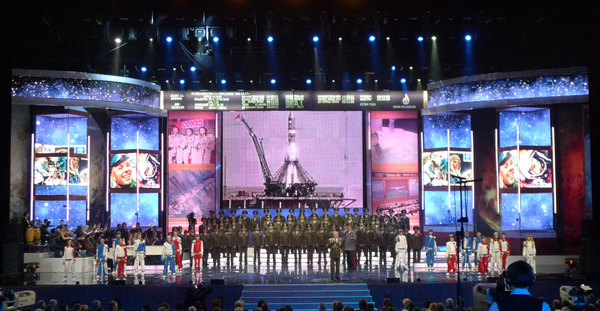The Latest from Boing Boing |  |
- Realistic dinosaur puppet scares and delights schoolchildren
- Vintage Soviet science and space illustration
- Last Supper on skateboard decks, with Mexican wrestlers
- Why People Think Cell Phones Cause Cancer
- Make's roundup of DIY radiation detectors
- Kotaku: new Nintendo console to be more poweful than Xbox 360, PS3
- RIM PlayBook tablet is Palm Foleo killer
- Two mint tin electronics kits: $30
- Found Sign: Why the Internet is No Substitute for a Library
- iGeiger: Geiger Counter with an iPhone interface
- In case you missed it: Xeni on Chris Hardwick's NERDIST podcast
- Study: Pot smokers may lack energy, but pot growers use lots of it
- Secret life of Banana Slugs
- Russia: Cosmonaut's Day and Yuri Gagarin gala at the Kremlin (video)
- Automatically generate regular expressions with Txt2re
- Stack of 3D models of history's space rockets
- Counterfeit gadget trade surges
- Spontaneous human combustion at a porn shop?
- Retro LCD handheld game simulator
- How effective can tsunami warning systems really be?
- Great Moments in Pedantry: Pie charts aren't so bad, after all
- Trusting unknown parties for security? Welcome to the web
- Proof that David Attenborough has invaded your consciousness
- Bulldog, bird, and squirrel in strange affinity
- How To: Build a radiation detector out of a digital camera
- Will Eisner's cool 3D titles for his Spirit comic
- Another aftershock? Or just an earthquake hangover?
- Antarctica, 1911
- Lego Lovecraft house, with bricky tentacles
- Tell Congress: Unlock science research!
| Realistic dinosaur puppet scares and delights schoolchildren Posted: 14 Apr 2011 10:32 PM PDT These Australian schoolchildren were treated to a visit from an extremely lifelike dinosaur puppet. Between the virtuoso performance by the puppeteer and the great design of the puppet, this is a hell of a performance. Walk the dinosaur (via JWZ) |
| Vintage Soviet science and space illustration Posted: 14 Apr 2011 10:19 PM PDT  This site collects vintage Soviet space and science illustrations; most appear to come from old children's books. They're eerily similar to American illos from the same era -- both empires believing that they were rocketing to a space-age, hypermodernist, Tomorrowland/Rollerball future. Russian Science Illustrations from the 60's and 70's (Thanks, Shopsinc!) |
| Last Supper on skateboard decks, with Mexican wrestlers Posted: 15 Apr 2011 12:13 AM PDT  "The Last Fiesta" is a Last Supper rendered on 12 skateboard decks, with Christ and the apostles depicted as Mexican masked wrestlers. Chris Parks, the artist, included a supper of The Last Fiesta (via Neatorama) |
| Why People Think Cell Phones Cause Cancer Posted: 14 Apr 2011 02:56 PM PDT  Images: Shutterstock (1, 2) Siddhartha Mukherjee deftly tells you everything you need to know about the current state of knowledge of the risks to human health from use of cellular phones. Mukherjee, a doctor and professor of medicine at Columbia, does so in a few thousand words in the New York Times without dismissing concerns, and while explaining why this issue is so fraught with interpretation bias and confusion. Mukherjee's key points are well understood in epidemiological circles, and typically misstated in the mainstream press. They are: • Rates of cancer types expected to be associated with long-term mobile phone use have declined in America during the rise of cell calling. • The low incidence of such expected cancers in the general population makes it nearly impossible to conduct prospective longitudinal studies: find a large cohort of people with no disease and follow them for 5, 10, or 20 years to see in which groups normal and abnormal rates occur. • Retrospective studies that ask people to remember past usage of cell phones are deeply flawed due to recall bias. • Cellular tests examining DNA after exposure to phone emissions were found in a meta-review of papers and research to have no provable link. (Mukherjee also explains that the recently reported "cell phones make your brain light up" study showed unexplained brain activity when a silent cell phone was active in areas adjacent to the phone, which was near one or the other of a subject's ears. However, the brain activity wasn't harmful--it was similar to activity from other routine activities--just inexplicable. And the study only involved under 50 people.) I've been reading cell-phone and RF exposure studies for a decade, starting at a point where I was convinced that the industry must have known of a link and was trying to hide it. Who trusts multi-billion-dollar corporations with everything to lose, where executives might even be sent to prison as a result? Of course, they might hide evidence or fund fake studies. Images: Shutterstock (1, 2) Siddhartha Mukherjee deftly tells you everything you need to know about the current state of knowledge of the risks to human health from use of cellular phones. Mukherjee, a doctor and professor of medicine at Columbia, does so in a few thousand words in the New York Times without dismissing concerns, and while explaining why this issue is so fraught with interpretation bias and confusion. Mukherjee's key points are well understood in epidemiological circles, and typically misstated in the mainstream press. They are: • Rates of cancer types expected to be associated with long-term mobile phone use have declined in America during the rise of cell calling. • The low incidence of such expected cancers in the general population makes it nearly impossible to conduct prospective longitudinal studies: find a large cohort of people with no disease and follow them for 5, 10, or 20 years to see in which groups normal and abnormal rates occur. • Retrospective studies that ask people to remember past usage of cell phones are deeply flawed due to recall bias. • Cellular tests examining DNA after exposure to phone emissions were found in a meta-review of papers and research to have no provable link. (Mukherjee also explains that the recently reported "cell phones make your brain light up" study showed unexplained brain activity when a silent cell phone was active in areas adjacent to the phone, which was near one or the other of a subject's ears. However, the brain activity wasn't harmful--it was similar to activity from other routine activities--just inexplicable. And the study only involved under 50 people.) I've been reading cell-phone and RF exposure studies for a decade, starting at a point where I was convinced that the industry must have known of a link and was trying to hide it. Who trusts multi-billion-dollar corporations with everything to lose, where executives might even be sent to prison as a result? Of course, they might hide evidence or fund fake studies.
Over time, though, as I learned more of the science and read increasingly well-designed and comprehensive surveys, I found the evidence compelling. No credible research backs up an increased risk of cancer or other health risks. (If you write about this subject, and I imagine we'll see it in the comments, you'll be told that all the mainstream research except the few outlier studies is bogus and corrupted by the cellular industry, and that numerous other studies outside the scientific establishment prove a link.) Retrospective studies are the worst culprits here, because if you ask someone with cancer how often (and even on what side of the head) they used their cell phone during the last X years, you not surprisingly get a biased response. It is not their fault. They are looking for an explanation for their condition. I had a brush with cancer in the late 1990s. I'd like to believe it was because of exposure to some particular substance, but cancer that requires treatment (as opposed to the cancerous precursors that constantly grow in our bodies and are dispatched by our defenses) is proving to be a complex outcome of genetics, environmental causes, and random mischance. Mukherjee doesn't mention a related issue, which is that dozens of studies that have attempted to find an association between so-called electrosensitivity--an adverse reaction to the presence of normal levels of urban electromagnetic radiation--have found no correlation in self-identified sufferers, nor in control groups. You can read a meta-review of 46 studies involving 1175 sufferers from 2009 that concludes: "Despite the conviction of IEI-EMF sufferers that their symptoms are triggered by exposure to electromagnetic fields, repeated experiments have been unable to replicate this phenomenon under controlled conditions." (Some studies have found that such sufferers do have measurable symptoms and distress which they may experience in the lab, but that this happens whether or not EMF signals are in use.) Mukherjee explains one aspect of the problem with retrospective studies in regards to the international Interphone study of thousands of users across several countries. As a whole, no correlation between cell usage and brain tumors were found, but certain subsets of data analyzed separately produced contradictory results: regular phone users had decreased incidence and heavy phone users had increased risks. ...some men and women with brain cancer recalled a disproportionately high use of cellphones, while others recalled disproportionately low exposure. Indeed, 10 men and women with brain tumors (but none of the "controls") recalled 12 hours or more of use every day--a number that stretches credibility. In a substudy of Interphone, researchers embedded phones with special software to track phone usage. When this log was compared with the "recalled" usage, there were wide and random variations: some users underreported, while others overreported use. Mukherjee's article is intended to make a larger point: that there is a reasonable desire to want to find a true cause for an inexplicable illness or impairment, whether it's autism in your child or cancer in your partner's brain. We reach out for what we think are causative effects, whether or not the research ultimately backs this up. The Internet needs a kind of medal to hand out to writers who can summarize vast arrays of information into accurate, sensible, and fair articles that don't trivialize multiple facets of a complex issue into "on the one hand, on the other hand" presentations. Mukherjee would get my vote for the 2011 award even this early in the season. New York Times: Do Cellphones Cause Brain Cancer? |
| Make's roundup of DIY radiation detectors Posted: 14 Apr 2011 02:19 PM PDT  John Baichtal says: "MAKE's interview with hardware hacker Akiba highlighted a fascinating trend: individuals and small groups taking their safety into their own hands by creating, modifying, and networking radiation detectors, a.k.a. Geiger counters, rather than relying on governments for information. The following projects and kits aim to put Geiger counters in the hands of ordinary makers." John Baichtal says: "MAKE's interview with hardware hacker Akiba highlighted a fascinating trend: individuals and small groups taking their safety into their own hands by creating, modifying, and networking radiation detectors, a.k.a. Geiger counters, rather than relying on governments for information. The following projects and kits aim to put Geiger counters in the hands of ordinary makers." DIY Geiger Counters Take Center Stage
|
| Kotaku: new Nintendo console to be more poweful than Xbox 360, PS3 Posted: 14 Apr 2011 12:47 PM PDT Kotaku today reports that a new Nintendo console set to debut at E3 in June will be "more powerful" than the Xbox 360 and PlayStation 3. (thanks, Joel Johnson) |
| RIM PlayBook tablet is Palm Foleo killer Posted: 14 Apr 2011 12:55 PM PDT The first reviews of RIM's PlayBook tablet, which needs to be tethered to a Blackberry to do native email, are in. It's shit. One of the company's two CEOs also walked out of a BBC interview when asked about the RIM's "problems" with governments who want access to its security systems. |
| Two mint tin electronics kits: $30 Posted: 14 Apr 2011 12:08 PM PDT  Maker Shed is running a good deal on its Mintduino and Mintronics Survival Pack kits. You get both for $29.98. The MintDuino is the newest product in our Mintronics series of kits. It's perfect for anyone interested in learning, or teaching, the fundamentals of how micro controllers work. Inspired by Tom Igoe's Arduino tutorials, the MintDuino will have you building your very own ATMega based micro controller from scratch on a breadboard. Afterwards, you can easily programming it from almost any computer via an FTDI programmer (not included) and the Arduino IDE. |
| Found Sign: Why the Internet is No Substitute for a Library Posted: 14 Apr 2011 12:25 PM PDT Joe Sabia says, "This is a sign that hangs from the wall of my local public library in Milford, Connecticut. It's a large but quaint building occupied by maybe 6 or so people, and 3 elderly kind women at the check out desk." Click for larger size. Update: Boing Boing pal Seth Godin writes, Apparently, it comes from this book which is in itself quite an amusing read, as far as the reviews indicate... |
| iGeiger: Geiger Counter with an iPhone interface Posted: 14 Apr 2011 12:00 PM PDT  Sean Bonner shares word (and photos!) of initial prototypes for an iPhone-connected geiger counter, developed with folks in Japan in mind. (rdtn.org) |
| In case you missed it: Xeni on Chris Hardwick's NERDIST podcast Posted: 14 Apr 2011 11:31 AM PDT I was recently a guest on Chris Hardwick's very popular and very funny "Nerdist" podcast. You can listen to the fun here. |
| Study: Pot smokers may lack energy, but pot growers use lots of it Posted: 14 Apr 2011 11:29 AM PDT A report issued this week by an energy analyst at Lawrence Berkeley National Laboratory says that people who grow marijuana indoors use 1 percent of the U.S. electricity supply, and create 17 million metric tons of carbon dioxide every year, not whatever they exhale. After medical pot use became legal in California in 1996, according to this study, per-person residential electricity use in Humboldt County jumped 50 percent compared to other parts of the state. More here. (thanks, Miles O'Brien) |
| Posted: 14 Apr 2011 11:03 AM PDT KQED QUEST teaches us about Banana Slugs, detritivores that scarf up dead leaves, poop, and even dead animals in California's old growth redwood forests. Science on the SPOT: Banana Slugs Unpeeled |
| Russia: Cosmonaut's Day and Yuri Gagarin gala at the Kremlin (video) Posted: 14 Apr 2011 05:44 PM PDT President Dmitry Medvedev opened the evening with a speech about Russian superiority in space. In attendance were many current and former cosmonauts, lots of top military brass and state officials, some NASA folks, and Russian celebrities like the ex-spy and Russian hero Anna Chapman. Also in Moscow that week for the festivities were a number of the 7 private citizens who've paid to travel to space: Charles Simonyi, Greg Olsen, Anousheh Ansari, Mark Shuttleworth, Richard Garriott, and Dennis Tito, along with Eric Anderson, founder of Space Adventures, the company which made their space flights with the Russian space program possible. Miles' report for PBS is here. Embedded above (and here) is a quick little video snip from one of the acts that performed an ode to the cosmonauts in front of space b-roll. I'm afraid I didn't get their name; there was a programme in Cyrillic, but I didn't end up with a copy, and my seat-mates didn't speak Russian so we couldn't understand the on-stage emcees. As we walked out of the theater, it was snowing. The military choir finale (which I did not video, alas) was a potent earworm, and we sang it aloud as we all trudged back to the hotel. [YouTube Link]. More photos below (click each to view larger size, all photos shot by yours truly).
Previously: Cosmonaut's Day in Moscow: Notes from Yuri Gagarin gala inside the Kremlin
|
| Automatically generate regular expressions with Txt2re Posted: 13 Apr 2011 10:32 PM PDT  A programmer who hates coming up with regular expressions has produced a visual tool for automatically generating them. You paste in a block of text, identify the parts of it you'd like your regexp to catch, and it produces an (admittedly inelegant but absolutely functional) regexp ready for your use. The programmer explains, "It's free because I have been helped in my career so much by the programmers who generated free systems like linux, apache, php and mysql - this is the only free labour that I have ever given back to the community." So what does txt2re do?Txt2re (via Kottke) |
| Stack of 3D models of history's space rockets Posted: 14 Apr 2011 11:35 AM PDT  Space Hacker Ariel Waldman points us to Sascha Pohflepp's The Rocket, "Every freely available 3D-model of space rockets as found on Google 3D Warehouse, chronologically ordered and assembled into one unbroken chain of our attempts to transcend the gravity well." The Rocket |
| Counterfeit gadget trade surges Posted: 14 Apr 2011 10:09 AM PDT Gizmodo's Brian Gardiner checks out the epic-scale market for counterfeit audio gear. Early on the morning of October 28, 2010 a massive strike force assembled outside the Meipai Electronic Audio Factory and three other storage facilities in and around Southern China's Enping City. What had started out as a tip from a handful of major audio equipment makers led to a months-long investigation by Guangdong Public Security Department and Jiangmen City police. By day's end, four people were in jail and 1,200 counterfeit audio items were in police hands, and the so-called "New Dynamics Audio Equipment Factory" was effectively shut down. It was the first salvo in a new war against fake wares, lead by an unlikely coalition of audio companies who, though fierce competitors in stores, are closely allied against a common enemy.And it's not just in Asia: a recent raid in the UK netted $500k worth of fakes, the largest ever there. One driving force is the increasing quality of knock-offs and their easy availability online: fakes so good that they sell for only slightly less than real ones. |
| Spontaneous human combustion at a porn shop? Posted: 14 Apr 2011 09:48 AM PDT A fellow was hospitalized last night after catching fire inside a private video booth at a San Francisco porn shop. How the fire started remains a mystery. What do you think? Crack pipe and blow torch lighter? Poppers and a cigarette? Spontaneous human combustion? From CBS Local: Police officers across the street from the porn shop saw a man run out the front door of the store "engulfed in flames," an SFPD spokesman said."Man 'Engulfed In Flames' At San Francisco Porn Shop" (Thanks, Loren Coleman!) |
| Retro LCD handheld game simulator Posted: 14 Apr 2011 09:36 AM PDT |
| How effective can tsunami warning systems really be? Posted: 14 Apr 2011 09:35 AM PDT |
| Great Moments in Pedantry: Pie charts aren't so bad, after all Posted: 14 Apr 2011 09:28 AM PDT  Yes, that is a chart comparing the effectiveness of different kinds of charts. Apparently, it is Super Meta Science Day here at BoingBoing. Pie charts get no respect, but Robert Kosara, Assistant Professor of Computer Science at UNC Charlotte, thinks the chart's bad reputation for being misleading isn't in line with the actual evidence. In particular, he cites a 1991 study that showed no significant differences between how well pie charts conveyed information, compared to other kinds of charts—unless the questions people were trying to use charted information to answer were particularly complex. In that case, pie charts were actually better than bar charts and tables.
Eager Eyes: In Defense of Pie Charts Via Will Knight |
| Trusting unknown parties for security? Welcome to the web Posted: 14 Apr 2011 09:47 AM PDT  At The Economist, Glenn Fleishman writes about a fundamental flaw in the industry standard security system for websites, SSL, familiar to all of us as the little lock icon that appears for 'secure' websites. Recently, a cracker was able to issue himself security certificates for domains at Skype and elsewhere, making clear the problem of assigning trust to certificating authorities just because. At The Economist, Glenn Fleishman writes about a fundamental flaw in the industry standard security system for websites, SSL, familiar to all of us as the little lock icon that appears for 'secure' websites. Recently, a cracker was able to issue himself security certificates for domains at Skype and elsewhere, making clear the problem of assigning trust to certificating authorities just because. The secure web infrastructure was designed in part to defend against this. The browser may be tricked into connecting to a server designed to extract your identity or intercept communications, but the browser will see the wolf under the sheep's clothing. It will alert the user and hinder him from connecting to a server that lacks a certificate, issued by some CA, for the domain it claims to be representing. But if a valid certificate can be obtained, neither the user nor the browser have any idea that they have been hijacked.A big part of the problem seems to be the willingness of browser- and OS-makers to turn a blind eye to sleazy CAs. The web's trust issues [The Economist] |
| Proof that David Attenborough has invaded your consciousness Posted: 14 Apr 2011 09:10 AM PDT It is utterly impossible to read this article about the mating habits of birds of paradise—written by David Attenborough—without hearing it in your head in David Attenborough's voice. (Via Mark Changizi) |
| Bulldog, bird, and squirrel in strange affinity Posted: 14 Apr 2011 09:09 AM PDT  "A trio comprising a canary bird, a bulldog, and a gray squirrel, has for some unknown reason, entered into strange mutual relation." -- Popular Mechanics, 1921 "A trio comprising a canary bird, a bulldog, and a gray squirrel, has for some unknown reason, entered into strange mutual relation." -- Popular Mechanics, 1921 (Via Mostly Forbidden Zone) |
| How To: Build a radiation detector out of a digital camera Posted: 14 Apr 2011 09:04 AM PDT Obviously, this is probably not the most accurate or sensitive way to measure radiation. It's also showing you relative increases or decreases, not exact numbers. Nevertheless, this hack, worked out by Andrew Lathrop, is pretty damn cool. Via PopPhoto and Leisa Fearing. |
| Will Eisner's cool 3D titles for his Spirit comic Posted: 14 Apr 2011 09:02 AM PDT  Mirko Ilic of Imprint presents a gallery of hand-drawn 3-D comic book titles, with emphasis on Will Eisner's amazing Spirit titles. But everything changed with the appearance of Will Eisner's "The Spirit" (1940). "The Spirit" was published as a seven-page supplement to the comics section of American Sunday newspapers. As a supplement tucked inside newspapers, "The Spirit" did not depend on being visible on the newsstands. It was not limited by the need for recognizable branding like "Superman". Mr. Eisner used that extremely cleverly by going in exactly the opposite direction. Not only did he change the masthead of "The Spirit" for every issue, but very soon, the masthead became an integral part of the scene/set. Eisner continued to play with the masthead even when "The Spirit" started to be sold on newsstands as an independent booklet.The Spirit of the Stone Type |
| Another aftershock? Or just an earthquake hangover? Posted: 14 Apr 2011 08:54 AM PDT Jishin-yoi means "earthquake drunk"—the feeling that you're experiencing the ground moving beneath you, even when things are still. It might be psychological. It might be a physical balance impairment. Whichever it is, a doctor at the University of Tokyo Hospital estimates that 30% of Japanese living in quake-stricken regions have experienced it. (Via Samuel Rubenfeld) |
| Posted: 14 Apr 2011 08:48 AM PDT |
| Lego Lovecraft house, with bricky tentacles Posted: 14 Apr 2011 10:10 AM PDT  Lego artist Mr Xenomurphy created this great Lovecraftian horror-house, complete with Lego tentacles. Tentacles have so clearly been missing from Lego for all these years, it's a wonder they aren't standard issue now. Lego artist Mr Xenomurphy created this great Lovecraftian horror-house, complete with Lego tentacles. Tentacles have so clearly been missing from Lego for all these years, it's a wonder they aren't standard issue now. Homage to H. P. Lovecraft (Thanks, Lovecraftsman!) |
| Tell Congress: Unlock science research! Posted: 14 Apr 2011 08:38 AM PDT Aaron Swartz from Demand Progress sez, "The NIH is the largest source of funding for scientific research in the world. Three years ago this week, it announced every paper it funded would have to be made open access -- put online for free, instead of locked up by a for-profit publishing company. The change has been a huge success, so this week a coalition of libraries, universities, and patient advocacy groups is asking people to demand other US government funding agencies do the same. Can you take a second to send a message? -- we make it real easy." Tell The White House And Congress: Unlock Science Research (Thanks, Aaron!) |
| You are subscribed to email updates from Boing Boing To stop receiving these emails, you may unsubscribe now. | Email delivery powered by Google |
| Google Inc., 20 West Kinzie, Chicago IL USA 60610 | |












No comments:
Post a Comment